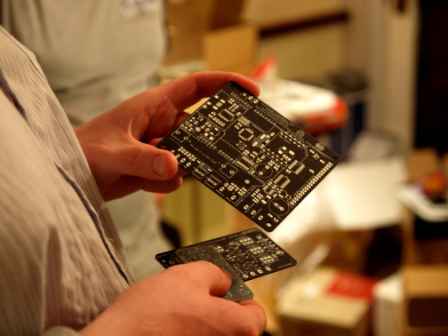Melbourne April Grant – HackerSpace ArduinoLab
May 24, 2011
At the end of April the Melbourne Awesome Foundation met for dinner, and chose the Melbourne HackerSpace ArduinoLab as the grant recipient.
I have to admit I didn’t totally understand their project, but the energy for their project from all the other micro-trustees was so awesome, I trusted that and gave them my vote too. We called the guys immediately, and they were thrilled to receive the grant. They were working on their project while we were eating dinner on Saturday night!

Here’s their blog to explain what they do – I certainly can’t. 🙂
And here’s their submission:
Who: Founder of the Melbourne HackerSpace (not-for-profit community technology group)
Project: High-school science portable electronics laboratory-in-a-box
Awesomeness: Promotes science experimentation in schools with an affordable device that is open and customisable/extensible by teachers and students.
How: The Melbourne HackerSpace has completed the initial design/prototype and has the members and track record in completing several previous projects of this complexity. We work closely with Freetronics (http://freetronics.com), a local Melbourne company that can manufacture/distribute open-source hardware designs on behalf of others.
Overview: The ArduinoLab is a portable unit consisting of a graphics screen, buttons/knobs for user interface … as well as several controllable “hardened/protected” input/output channels that can generate signals (standard and custom waveforms) and measure physical quantities.
This general purpose device can be used to enhance science experiments by providing precise electronic control and measurement. For example, if students are studying the effects of moisture and sunlight on plant growth, the ArduinoLab can measure, record and chart the levels of light and water over the course of several weeks, whilst relaying that information to a PC (via a wireless connection).
The ArduinoLab comes ready-to-use with a simple user interface for general control of the inputs / outputs.
A key feature is that all the hardware / software is completely open and published on-line. Students can make the ArduinoLab from scratch or customise and extend one, to suit their needs. Software, including the user interface, can be easily tailored to suit any science project, especially those designed by students.
Specific features:
– Low-cost unit made from readily available, affordable parts
– Graphics LCD (128 x 64 pixels)
– Adjustable power source
– 3 channel digital / analog outputs
– 3 channel analog inputs
– Voltage / frequency measurement
– Custom waveform generation
– Wireless network (Zigbee / RFBee) back to a PC
– Built-in buzzer
– Portable with AA LiPo battery, charged via standard USB cable
– Modular software libraries making it easy to add new applications / user interface
– 100% Arduino compatible … large open technology community
– Hardware extensible via Arduino compatible shields (daughter boards)
– Software extensible using popular, cross-platform Arduino development environment
The HackerSpace guys, Andy Gelme and Paul Szymkowiak, were considering writing this blog post themselves, but as they’ve been so busy on the project, yours truly is doing the publishing.
We’re excited to hear how all the experimentation goes!